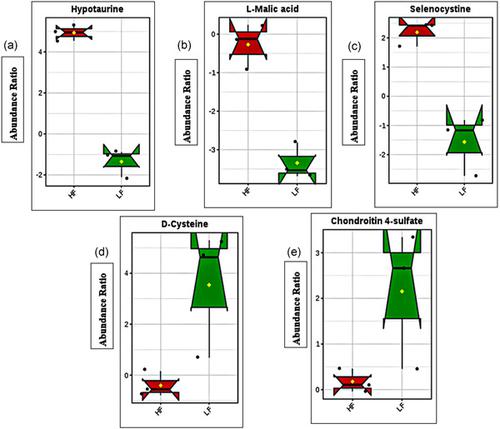当前位置:
X-MOL 学术
›
Mol. Reprod. Dev.
›
论文详情
Our official English website, www.x-mol.net, welcomes your
feedback! (Note: you will need to create a separate account there.)
Metabolomic fingerprinting of bull spermatozoa for identification of fertility signature metabolites.
Molecular Reproduction and Development ( IF 2.7 ) Pub Date : 2020-05-26 , DOI: 10.1002/mrd.23354 Kaustubh K Saraf 1 , Arumugam Kumaresan 1 , Mohua Dasgupta 1 , Gayathree Karthikkeyan 2 , Thottethodi Subrahmanya Keshava Prasad 2 , Prashant K Modi 2 , Kerekoppa Ramesha 3 , Sakthivel Jeyakumar 3 , Ayyasamy Manimaran 3
Molecular Reproduction and Development ( IF 2.7 ) Pub Date : 2020-05-26 , DOI: 10.1002/mrd.23354 Kaustubh K Saraf 1 , Arumugam Kumaresan 1 , Mohua Dasgupta 1 , Gayathree Karthikkeyan 2 , Thottethodi Subrahmanya Keshava Prasad 2 , Prashant K Modi 2 , Kerekoppa Ramesha 3 , Sakthivel Jeyakumar 3 , Ayyasamy Manimaran 3
Affiliation

|
The objective of the study was to identify the fertility‐associated metabolites in bovine spermatozoa using liquid chromatography‐mass spectrometry (LC‐MS). Six Holstein Friesian crossbred bulls (three high‐fertile and three low‐fertile bulls) were the experimental animals. Sperm proteins were isolated and protein‐normalized samples were processed for metabolite extraction and subjected to LC‐MS/MS analysis. Mass spectrometry data were processed using iMETQ software and metabolites were identified using Human Metabolome DataBase while, Metaboanalyst 4.0 tool was used for statistical and pathway analysis. A total of 3,704 metabolites belonging to various chemical classes were identified in bull spermatozoa. After sorting out exogenous metabolites, 56 metabolites were observed common to both the groups while 44 and 35 metabolites were found unique to high‐ and low‐fertile spermatozoa, respectively. Among the common metabolites, concentrations of 19 metabolites were higher in high‐fertile compared to low‐fertile spermatozoa (fold change > 1.00). Spermatozoa metabolites with variable importance in projections score of more than 1.5 included hypotaurine, d ‐cysteine, selenocystine. In addition, metabolites such as spermine and l ‐cysteine were identified exclusively in high‐fertile spermatozoa. Collectively, the present study established the metabolic profile of bovine spermatozoa and identified the metabolomic differences between spermatozoa from high‐ and low‐fertile bulls. Among the sperm metabolites, hypotaurine, selenocysteine, l ‐malic acid, d ‐cysteine, and chondroitin 4‐sulfate hold the potential to be recognized as fertility‐associated metabolites.
中文翻译:

牛精子的代谢组学指纹图谱,用于鉴定生育特征性代谢物。
这项研究的目的是使用液相色谱-质谱法(LC-MS)鉴定牛精子中与生育力相关的代谢产物。实验动物为六头荷斯坦黑白花杂交公牛(三头高肥力公牛和三头低肥力公牛)。分离出精子蛋白质,并对蛋白质标准化的样品进行代谢物提取,然后进行LC-MS / MS分析。使用iMETQ软件处理质谱数据,并使用人类代谢组数据库识别代谢产物,同时使用Metaboanalyst 4.0工具进行统计和路径分析。在牛精子中共鉴定到3,704种代谢物,属于不同化学类别。挑选出外源代谢物后,两组均观察到56种代谢物,而高和低生育力精子分别发现44种和35种代谢物。在常见的代谢物中,高生育力的19种代谢物的浓度高于低生育力的精子(倍数> 1.00)。在预测得分大于1.5时具有重要重要性的精子代谢产物包括次牛磺酸,d-半胱氨酸,硒代半胱氨酸。此外,仅在高繁殖力的精子中鉴定出了诸如精胺和l-半胱氨酸等代谢物。总体而言,本研究建立了牛精子的代谢谱,并确定了高和低肥力公牛精子之间的代谢组学差异。在精子代谢物中,次牛磺酸,硒代半胱氨酸,l-苹果酸,d-半胱氨酸和硫酸软骨素有被认为是与生育力相关的代谢物。
更新日期:2020-06-28
中文翻译:

牛精子的代谢组学指纹图谱,用于鉴定生育特征性代谢物。
这项研究的目的是使用液相色谱-质谱法(LC-MS)鉴定牛精子中与生育力相关的代谢产物。实验动物为六头荷斯坦黑白花杂交公牛(三头高肥力公牛和三头低肥力公牛)。分离出精子蛋白质,并对蛋白质标准化的样品进行代谢物提取,然后进行LC-MS / MS分析。使用iMETQ软件处理质谱数据,并使用人类代谢组数据库识别代谢产物,同时使用Metaboanalyst 4.0工具进行统计和路径分析。在牛精子中共鉴定到3,704种代谢物,属于不同化学类别。挑选出外源代谢物后,两组均观察到56种代谢物,而高和低生育力精子分别发现44种和35种代谢物。在常见的代谢物中,高生育力的19种代谢物的浓度高于低生育力的精子(倍数> 1.00)。在预测得分大于1.5时具有重要重要性的精子代谢产物包括次牛磺酸,d-半胱氨酸,硒代半胱氨酸。此外,仅在高繁殖力的精子中鉴定出了诸如精胺和l-半胱氨酸等代谢物。总体而言,本研究建立了牛精子的代谢谱,并确定了高和低肥力公牛精子之间的代谢组学差异。在精子代谢物中,次牛磺酸,硒代半胱氨酸,l-苹果酸,d-半胱氨酸和硫酸软骨素有被认为是与生育力相关的代谢物。











































 京公网安备 11010802027423号
京公网安备 11010802027423号